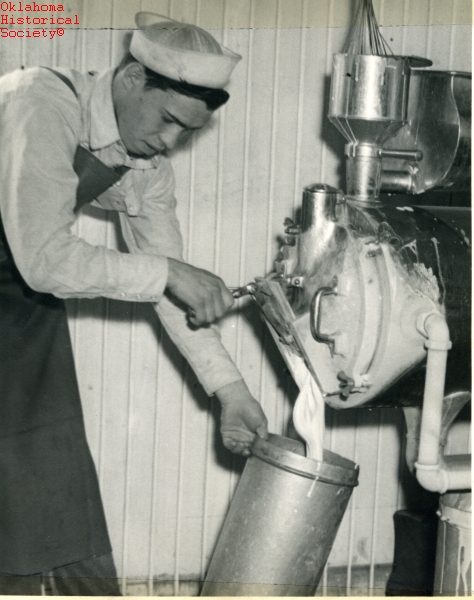DAIRY INDUSTRY.
After the federal government released the Unassigned Lands to settlement in 1889, milk cow numbers grew rapidly in Oklahoma Territory from 22,000 in 1890 to 275,000 in 1900. That growth was amplified by several technological advances, including commercial pasteurization, automated milking machines, and refrigeration.
Oklahoma dairy cow numbers increased through the Great Depression and peaked in 1943 at 912,000. Each produced an annual average of 3,240 pounds of milk for a total of 2.7 million pounds. In 1986 numerous Oklahoma dairy farmers took advantage of the U.S. government's national herd buyout program, sold their cattle, and left the industry. By 2003 milk cow numbers had dropped to eighty-two thousand. Each produced an annual average of fifteen thousand pounds of milk for a total of 1.31 billion pounds. Grady County has consistently led the state in dairy cow population.
The first dairy barn on the campus of Oklahoma A&M College (now Oklahoma State University, OSU), was built circa 1920. In 1948 the eighty-head barn was replaced with a ninety-two-stanchion facility. The present milking parlor was built in 1987. In 1928 a three-story dairy science building was constructed, and it housed the Departments of Dairy Science and Agricultural Economics until 1962. Bachelor of science degrees in dairy science were awarded at OSU until in 1971 the departments of Animal Husbandry, Poultry Science, and Dairy Science were combined into the Department of Animal Science. A dairy cattle judging team and a dairy science club have existed at OSU since about 1923, and a dairy products judging team began in 1928. Other state-run dairy farms include one at McAlester's Oklahoma State Penitentiary.
Past and present OSU dairy science faculty who received regional and/or national awards from the American Dairy Science Association include Harry W. Cave (1950), Harold C. Olson (1962), Stanley E. Gilliland (1987, 1992), and Leon J. Spicer (2004). Oklahomans honored as dairy industry pioneers by the National Dairy Shrine of Fort Atkinson, Wisconsin, were ice cream expert Arthur C. Baer, Jersey breeder Robert L. Peebly, and OSU professors Paul C. McGilliard and Charles L. Norton.
In 1938 B. S. "Cheebie" Graham and Samuel F. Howe started the Central Oklahoma Milk Producer's Association, a Murray County marketing cooperative that merged with the American Milk Producers, Inc., (AMPI) in 1967. Dairy Farmers of America took over AMPI in 1998 and currently processes the majority of Oklahoma-produced milk. In 1941 several dairy farmers developed the Watonga Cheese Factory at Watonga to produce cheese. It was one of about ninety Oklahoma dairy product manufacturers in 1955, was one of approximately thirty in 1976, and was one of only five active plants in 2004. The factory subsequently closed, and the annual Watonga Cheese Festival, which had begun in 1976, ended.
William H. "Bill" Braum opened twenty-four Braum's Ice Cream and Dairy Stores in Oklahoma in 1968. In 1975 the Braum's dairy herd was moved from Emporia, Kansas, to Tuttle, Oklahoma, and there a new milking facility was built in 1993. In 2004 more than 280 Braum's stores existed in Oklahoma and four surrounding states. Other dairy manufacturers that have been active in Oklahoma include Swan Brothers Dairy of Claremore, Farm Fresh, and Hiland Dairy.
During the 1950s Oklahoma dairy operators started using the Dairy Herd Improvement Association (DHIA) record-keeping system and began breeding cows using artificial insemination. The Oklahoma DHIA testing laboratory was housed on the OSU campus until it merged with the Heart of America DHIA in Kansas in 1995. Oklahomans recognized for breed improvement include L. R. and Stanley R. Covey (Ayrshires); Ellis A. Woods and Oliver Kinzie (Jerseys); Jene E. Mungle and Ernest R. Berousek (Guernseys); Elmer von Tungeln (Milking Shorthorns); and William E. Bugg, Robert Yoeman, and Glenden Adams (Holsteins).
In 1984 Langston University established the internationally acclaimed American Institute for Goat Research. Facilities include a 150-goat dairy, a creamery, and a DHIA testing laboratory. In 1990 the institute's name was changed to the E. (Kika) de la Garza Institute for Goat Research. On November 1, 2002, milk was named Oklahoma's official state beverage.
See Also
Learn More
R. B. Becker, "Our Dairying Industry," My Oklahoma 1 (June 1927).
"Cattle Industry," Vertical File, Research Division, Oklahoma Historical Society, Oklahoma City.
Donald E. Green, A History of the Oklahoma State University Division of Agriculture (Stillwater: Oklahoma State University, 1990).
W. C. Jamieson, "My Experiences as a Dairyman" (M.S. thesis, Oklahoma A&M College, 1929).
Gaston Litton, History of Oklahoma at the Golden Anniversary of Statehood, Vol. 2 (New York: Lewis Historical Publishing Co., 1957
Citation
The following (as per The Chicago Manual of Style, 17th edition) is the preferred citation for articles:
Leon J. Spicer, “Dairy Industry,” The Encyclopedia of Oklahoma History and Culture, https://www.okhistory.org/publications/enc/entry?entry=DA003.
Published January 15, 2010
© Oklahoma Historical Society



